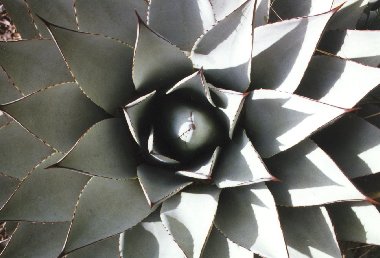Agaves are one of the most conspicuous
plants of arid regions, with their long, spiked leaves which form
symmetrical rosettes. Parry's agave are a large species with gray-green
spatula
 shaped
leaves which grow to 20" in length. The plant typically grows on dry,
rocky slopes between 4500' - 8000'. shaped
leaves which grow to 20" in length. The plant typically grows on dry,
rocky slopes between 4500' - 8000'.
|
Agaves are also known as century
plants, though they typically only live about 25% that long. |
As the plant reaches maturity it begins to store large
quantities of starch and sugar in the heart tissue. At about 25 years of
age the agave uses these carbohydrates to fuel the rapid development of
a towering flower stalk, which grows to heights of almost 20'. The plant
blooms only once in its lifetime, producing bright yellow flowers and a
large quantity of seeds. After this dramatic display, the agave dies.
Agaves have been used by Native Americans for a variety of purposes
including: food, soap, fiber, beverages and medicine. |

